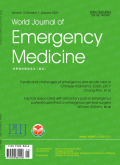首页|期刊导航|World Journal of Emergency Medicine|Prediction of sepsis within 24 hours at the triage stage in emergency departments using machine learning
World Journal of Emergency Medicine2024,Vol.15Issue(5):P.379-385,7.DOI:10.5847/wjem.j.1920-8642.2024.074
Prediction of sepsis within 24 hours at the triage stage in emergency departments using machine learning
摘要
关键词
Sepsis/Machine learning/Emergency department/Triage/Informatics分类
医药卫生引用本文复制引用
Jingyuan Xie,Jiandong Gao,Mutian Yang,Ting Zhang,Yecheng Liu,Yutong Chen,Zetong Liu,Qimin Mei,Zhimao Li,Huadong Zhu,Ji Wu..Prediction of sepsis within 24 hours at the triage stage in emergency departments using machine learning[J].World Journal of Emergency Medicine,2024,15(5):P.379-385,7.基金项目
supported by the National Key Research and Development Program of China(2021YFC2500803) (2021YFC2500803)
the CAMS Innovation Fund for Medical Sciences(2021-I2M-1-056). (2021-I2M-1-056)

